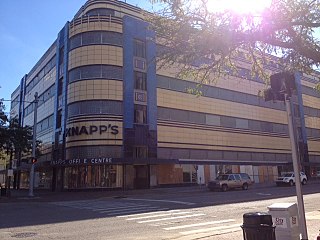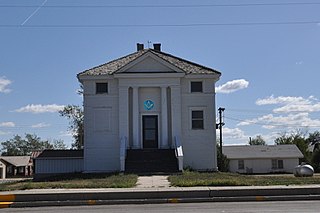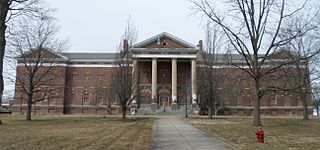
Lansing is the capital of the U.S. state of Michigan. It is mostly in Ingham County, although portions of the city extend west into Eaton County and north into Clinton County. The 2020 census placed the city's population at 112,644, making it the sixth most populous city in Michigan. The population of its metropolitan statistical area (MSA) was 541,297 at the 2020 census, the third largest in the state after metropolitan Detroit and Grand Rapids. It was named the new state capital of Michigan in 1847, ten years after Michigan became a state.

Jackson Field is a baseball stadium in Lansing, Michigan, home field of the Lansing Lugnuts minor league baseball team. The Michigan State Spartans college baseball team also plays select home games at Jackson Field. The stadium is situated in downtown Lansing in the Stadium District on a relatively narrow strip of land between and below Larch and Cedar streets.

The Capitol Loop is a state trunkline highway running through Lansing, Michigan, in the United States that was commissioned on October 13, 1989. It forms a loop route off Interstate 496 (I-496) through downtown near the Michigan State Capitol complex, home of the state legislature and several state departments. The Michigan Department of Transportation (MDOT) has labeled it as Capitol Loop I-496 or CL I-496 on some maps, similar to the Business Loop Interstate nomenclature. However, unlike other business loops in Michigan, it has unique reassurance markers—the signs that serve as regular reminders of the name and number of the highway. It is known internally at MDOT as Connector 496 for inventory purposes. The route follows a series of one-way and two-way streets through downtown Lansing, directing traffic downtown to the State Capitol and other government buildings. Unlike the other streets downtown, the seven streets comprising the Capitol Loop are under state maintenance and jurisdiction.

The Boji Tower, also known as the Michigan National Bank Building, is a historic 23-story building located at 124 Allegan Street, in Lansing, Michigan. It has been the tallest building in Lansing since its completion in 1931. On December 6, 2005, the building was added to the National Register of Historic Places as the Capital Bank Tower.

The Bonstelle Theatre is a theater and former synagogue owned by Wayne State University, located at 3424 Woodward Avenue in the Midtown Woodward Historic District of Detroit, Michigan. It was built in 1902 as the Temple Beth-El, and was listed on the National Register of Historic Places in 1982. As of 2023, the Bonstelle is planned to be renovated and integrated into a newly-constructed hotel.

The Schenley Farms Historic District, also referred to as the Schenley Farms–Oakland Civic District, is a historic district listed on the National Register of Historic Places that is located in the Oakland section of Pittsburgh, Pennsylvania, United States.
Masonic Temple Building may refer to:

The Cass Park Historic District is a historic district in Midtown Detroit, Michigan, consisting of 25 buildings along the streets of Temple, Ledyard, and 2nd, surrounding Cass Park. It was listed on the National Register of Historic Places in 2005 and designated a city of Detroit historic district in 2016.

Watertown Masonic Temple is a historic building and former Masonic hall located in Watertown in Jefferson County, New York. It was constructed in 1914 as a meeting hall for a local Masonic lodge and is a three-story building in the Neoclassical style, with a masonry and steel structure. The front of the building features a large prostyle temple front with six Doric columns supporting a triangular pediment.

The J.W. Knapp Company Building is a historic five-story, 190,000-square-foot (18,000 m2) Streamline Moderne building in Lansing, Michigan, United States. Designed by Orlie Munson of the Bowd–Munson Company, which also designed several other Art Deco landmarks in Lansing, including the Ottawa Street Power Station, it was constructed by the Christman Company in 1937 through 1938. The curvilinear look of the streamlined structure comes from huge plates of concrete faced with enamel, called "Maul Macotta", a copyrighted product of the Maul Macotta Company and prismatic glass brick windows. Alternating horizontal bands of yellow macotta and glass block are interrupted by vertical blue macotta pylons, rising from the building's four principal entrances. The pylons are pierced by windows. The entrance portals, display window aprons, and decorative banding are dark blue macotta. Red, yellow and blue spandrels, incorporating the letter "K" as a design element, decorate the entrance portals.

The Masonic Temple Building, located at 314 M.A.C. Avenue in East Lansing, Michigan, is a building constructed in 1916 for the Freemasons. It was listed on the National Register of Historic Places in 1999.

The Mt. Moriah Masonic Temple is a historic building in Kadoka, South Dakota. It was constructed in 1917, as a meeting hall for Mt. Moriah Lodge No. 155. The building was listed on the National Register of Historic Places in 2004 as Mt. Moriah Masonic Lodge No. 155. It has also been known as the Kadoka Masonic Hall.
Cooley Law School (Cooley) is a private law school in Lansing, Michigan and Riverview, Florida. It was established in 1972. At its peak in 2010, Cooley had over 3,900 students and was the largest US law school by enrollment; as of the Spring of 2022, Cooley had approximately 500 students between its two campuses. In November 2020, Western Michigan University's board of trustees voted to end its affiliation with Cooley, which began in 2014, with disassociation effective November 5, 2023.

Downtown Lansing is the central business district of Lansing, Michigan, United States. Located in the west-central part of the city along the banks of the Grand River, downtown Lansing is primarily home to Michigan's state government and three colleges, and also contains sports facilities, museums, entertainment and retail, and a growing residential population.

The WJBK-TV Studios Building is a broadcasting building located at 7441 Second Avenue in Detroit, Michigan. It was listed on the National Register of Historic Places in 2016. It is the only building in Detroit designed by noted Palm Beach, Florida architect John L. Volk. The property is currently owned by Halcor Studio Live LLC.

The Lansing Downtown Historic District is a primarily commercial and office historic district located in downtown Lansing, Michigan. The district stretches along the east side of Capitol Avenue from Ionia Street to Lenawee Street, and along both sides of Grand Avenue between Michigan and Washtenaw, with additional structures along Kalamazoo Street between Walnut and Grand and along Lenawee Street between Washington and Walnut. The district was listed on the National Register of Historic Places in 2009.

The Michigan School for the Blind (MSB) was a state-operated school for blind children in Michigan.

Bowd–Munson Company was an architectural firm in Lansing, Michigan. The firm was a partnership between Edwyn A. Bowd and Orlie Munson.

The City Hall Historic District is a commercial and municipal historic district located along East Michigan Avenue from Monroe to Jay Streets in Battle Creek, Michigan. It was listed on the National Register of Historic Places in 1996.


















